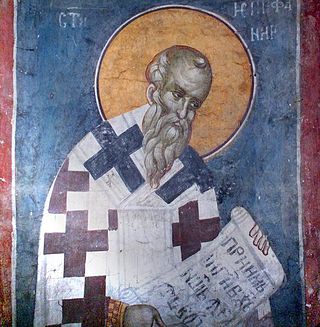Epifani wa Salamina
From Wikipedia, the free encyclopedia
Epifani wa Salamina (kwa Kigiriki: Ἐπιφάνιος; Besanduk, karibu na Eleutheropolis, leo Beit Guvrin, Israeli [1]310–320 hivi – 403) alikuwa mmonaki nchini Misri, halafu askofu wa Salamina, Kupro, maarufu kwa juhudi za kutetea imani sahihi ya Kanisa Katoliki[2].

Mwenye elimu kubwa na ujuzi wa maandiko ya Kikristo, msemaji wa lugha tano tofauti[3], anajulikana hasa kwa kitabu chake Panarion alichokitunga miaka 374-377 kwa ajili ya kupinga aina 80 za uzushi zilizoenea kati ya Wakristo[4].
Pamoja na hayo, aling'aa pia kwa maisha matakatifu, ukarimu kwa maskini na karama ya kufanya miujiza.
Tangu kale anaheshimiwa na Wakatoliki na Waorthodoksi kama mtakatifu na Baba wa Kanisa.
Maandishi
- The Panarion of Epiphanius of Salamis, Book I (Sects 1–46) Frank Williams, translator, 1987 (E.J. Brill, Leiden) ISBN 90-04-07926-2
- The Panarion of Epiphanius of Salamis, Book II and III (Sects 47–80, De Fide) Frank Williams, translator, 1993 (E.J. Brill, Leiden) ISBN 90-04-09898-4
- The Panarion of St. Epiphanius, Bishop of Salamis Philip R. Amidon, translator, 1990 (Oxford University Press, New York) (This translation contains selections rather than the full work.) ISBN 0-19-506291-4
- Epiphanius' Treatise on Weights and Measures: The Syriac Version, James Elmer Dean, ed, 1935. (Chicago) [English translation of On Weights and Measures; available at http://www.tertullian.org/fathers/epiphanius_weights_03_text.htm]
- Epiphanius de Gemmis: the Old Georgian Version and the Fragments of the Armenian Version. ed. Robert Pierpont Blake; de Vis, H. (1934). London: Christophers.
- Epiphanius von Salamis, Über die zwölf Steine im hohepriesterlichen Brustschild (De duodecim gemmis rationalis). Nach dem Codex Vaticanus Borgianus Armenus 31 herausgegeben und übersetzt by Felix Albrecht and Arthur Manukyan (Gorgias Eastern Christian Studies 37), 2014 (Gorgias Press: Piscataway) ISBN 978-1-4632-0279-8 (German edition).
Tazama pia
Tanbihi
Marejeo
Viungo vya nje
Wikiwand - on
Seamless Wikipedia browsing. On steroids.
